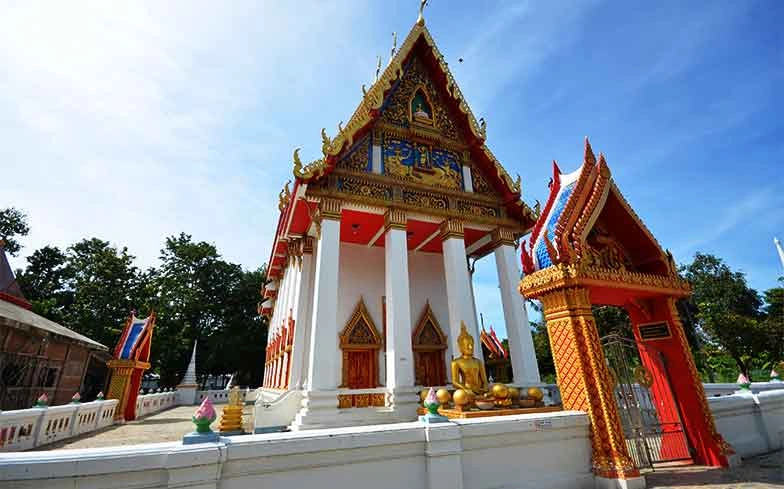Wat Ban Thung

Rating: 4/5 (5 votes)
Suphan Buri attractions
Attractions in Thailand
Operating day: Daily
Operating time: 08.00 - 17.00
Wat Ban Thung Sam Chuk, Sam Chuk, Suphan Buri. Around the year 1841, Sunthorn Phu, Thailand's and the world's renowned poet, traveled to Suphan Buri. He sought a particular mineral, which he referred to as Pun Mar or Pun Phet, believed to exist in the northern region of Suphan Buri. According to the beliefs of that era, this mineral could be transformed into gold. This journey served as the inspiration for one of his masterpieces, the "Niras Suphan", a poem chronicling his travels.
In the verses of "Niras Suphan," Sunthorn Phu mentioned staying in Ban Thueng for five nights. During his stay, he interacted with the villagers, ventured ashore to search for minerals in various locations, and returned to spend the night in the same village. It is said that Sunthorn Phu conducted experiments to transform the minerals into gold at Wat Ban Thueng, specifically near the reclining Buddha image (Phra Saiyasana).
Wat Ban Thueng, located in Sam Chuk Subdistrict, Sam Chuk District, Suphan Buri Province, is steeped in history. Originally, there were two adjoining temples, Wat Pho Ngoen and Wat Pho Thong. Wat Pho Ngoen is the current location of Wat Ban Thueng, while Wat Pho Thong now houses a public school.
Wat Ban Thueng is an ancient temple of historical significance. According to records, it was established during the reign of King U-Thong, the first monarch of Ayutthaya. During that time, a severe cholera epidemic claimed many lives. King U-Thong led his retinue out of the capital, traveling by wagon. When they reached Ban Thueng, the yoke of one of the wagons broke, prompting them to stop and repair it, which delayed their journey for several days.
King U-Thong ordered the construction of three temples in the area: Wat Bang Aek, Wat Ro, and Wat Ban Thueng. It is said that at one point, the King instructed his followers to ask the villagers for straw to feed the oxen, but the villagers refused. Later, he sent them to request leather for repairing the wagon yoke, and again the villagers declined. Frustrated by their stinginess, King U-Thong referred to the community as Ban Khi Thueng (the village of stingy people). Over time, this name evolved into Ban Thueng, as it is known today.
Another story suggests that the name originated from Chinese settlers who cleared the land to grow sugarcane and set up mills to produce sugar. In Chinese, the word "Tian" means "sweet" or "sugar." Whether the name derives from King U-Thong’s experience or the Chinese settlers’ activities remains uncertain, as many tales have been embellished over time to add intrigue or mystique to the site.
Comment
| Keyword (Advance) |
 Facebook Fanpage
Facebook Fanpage

 Category:
Category:  Group:
Group:  Art, Culture and Heritage
Art, Culture and Heritage Historical Sites and Monuments(
Historical Sites and Monuments( Landmarks and Memorials(
Landmarks and Memorials( Art, Craft Centres, Tradition(
Art, Craft Centres, Tradition( Museums(
Museums( Educational Places
Educational Places Educational Gardens, Farm(
Educational Gardens, Farm( Training Center(
Training Center( University
University Other religious and spiritural sites(
Other religious and spiritural sites( Suburban Living
Suburban Living Village, Community(
Village, Community( Local Market(
Local Market( Floating Market(
Floating Market( Nature and Wildlife
Nature and Wildlife National Parks and Marine Reserves(
National Parks and Marine Reserves( Mountain (Doi)(
Mountain (Doi)( Dam, Reservoir, Lake(
Dam, Reservoir, Lake( Caves(
Caves( Bays and Beaches(
Bays and Beaches( Entertainment and Agricultural
Entertainment and Agricultural Farm, Parks, Gardens and Ecotourism(
Farm, Parks, Gardens and Ecotourism( Theater(
Theater(